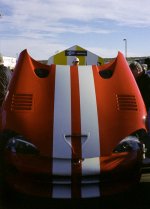TJV
Well-known
I've been scanning positives and negatives for about four years and currently use a Canon FS4000US dedicated film scanner. I use Vuescan Professional to drive it and have calibrated input to output with IT8 charts and colour spyders. Until recently I've been pretty must using slide film only for colour and HP5 for black and white. Black and white grain never bothers me. There's more R. Frank in me than Ansel Adams... Scanning slides my setup produces absolutely beautiful results. I never use any grain reduction, sharpening or FARE during the scan. In photoshop I use a multi-pass noise reduction and sharpening work flow to get rid of any "digital-noise" introduced by the scanner. I then sharpen for output. Starting to shoot colour negs only recently, I've been very disappointed by my scanners performance. There seems to be a massive amount more "digital noise," kind of like a pepper grain colour noise, similar to high ISO digi cam captures. No amount of per-channel despeckle or traditional noise reduction seems to help. There also seems to be a lot of grain aisling, making the film look like it's 3 stops more grainy.
Does anyone else out there have any experience with scanning negs/slides and has seen this? Has anyone moved from a FS4000US or other unit to a unit like the Nikon 5000ED and noticed an improvement in this area? Are modern dedicated scanners producing less colour and luminance noise than older units - has the same progression that has helped the DSLR market been seen in scanners? The FS4000US doesn't strictly have a multi-pass scan option, instead it must rescan from start to finish before starting a second sample scan from the start. The process makes my scans look VERY soft, even on only four passes, although the "noise" seems to improve a little. How does multi-pass improve scans in other units?
In short: How are other peoples neg scans looking compared to slide scans?
Thanks guys!
Does anyone else out there have any experience with scanning negs/slides and has seen this? Has anyone moved from a FS4000US or other unit to a unit like the Nikon 5000ED and noticed an improvement in this area? Are modern dedicated scanners producing less colour and luminance noise than older units - has the same progression that has helped the DSLR market been seen in scanners? The FS4000US doesn't strictly have a multi-pass scan option, instead it must rescan from start to finish before starting a second sample scan from the start. The process makes my scans look VERY soft, even on only four passes, although the "noise" seems to improve a little. How does multi-pass improve scans in other units?
In short: How are other peoples neg scans looking compared to slide scans?
Thanks guys!



